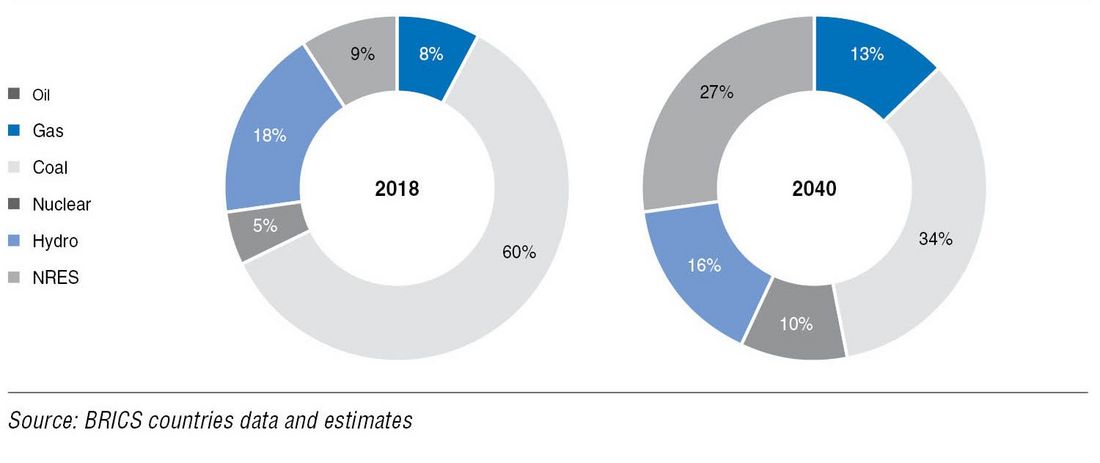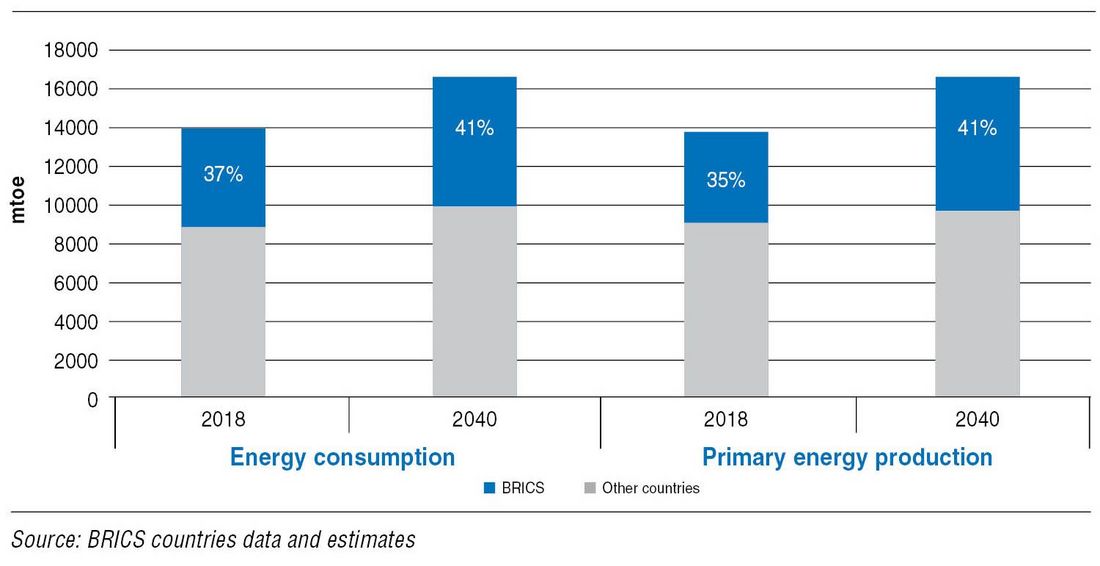Overview of BRICS Energy Report 2020 and Energy Technology Report 2020
The BRICS (Brazil, Russia, India, China and South Africa) countries conducted a study of their current and future energy and energy technology sectors. Experts of BRICS Energy Research Cooperation Platform guided by the Government ministries compiled a report, which details BRICS Energy sector trendsThe reports cover areas of collaboration as well as provide an overview of the total industry in the BRICS countries. This summary deals with the total BRICS overview. The reader can access the reports to study the details in each country.
This summary covers the Electric power sector mutual interest technologies, the current state and prospects in the combined energy sector and conclusions. This provides a brief overview of the types of technology and energy sources that are likely to play a role in the BRICS countries currently and up to 2040.

By Rob Stephen, Past President of CIGRE, Marcio Szechtman, Chairman of the CIGRE Technical Council, Olga Yudina, Russian Senior Official on the energy in BRICS, & Olga Frolova, Executive Director of CIGRE Russia
BRICS electric power sector mutual interests technologies
According to the survey results, the most commercially perspective are technologies related to digitalization and clean energy.
The most promising Electric power sector technologies:
- Grid monitoring
- Digital twins
- Smart Grid
- Smart electricity meters
- Hydrogen in a scalable commercial basis
The most promising general-purpose technologies:
- Telemetry (remote transmission of large amounts of data)
- Systems for autonomous processing and interpretation of seismic data
- Geodata systems
- Virtual reality for personnel training
- Analysis of equipment malfunctions
The Report reflects as well the technological potential by country.
Brazil can supply bioethanol energy technologies such as hybrid cars with engines that operate on ethanol, wind and biomass, Industrial designs of hydrogen powered hybrid trucks.
China is advanced in production of hydrogen gas stations and hydrogen fuel cells for automotive applications, energy storage systems, ultra-high transmission and electric power grids digitalisation technologies, wind farms with capacity up to 50 GW.
South Africa can supply solar energy technologies such as high-tech heterostructure photovoltaic cells, the integration of photovoltaic elements in architectural solutions and transport, construction of solar power stations of increased power.
India may become a supplier of modern gearboxes for wind turbines, technologies for creating industrial marine wind parks, hybrid towers for offshore wind energy.
Current state and prospects of the BRICS energy sector development
The BRICS energy sector supplies energy to 40% of the World's population (3.08 billion people) or 37% of global energy consumption, accounting 42% of renewable energy use and about 43% of CO2 emissions. In many ways, the trends in the development of energy in the BRICS countries are crucial for the development of the global energy sector.
As reflected in Figure 1 and Figure 2 at present coal accounts for around 50% of the total energy consumed with petroleum products and natural gas 13%, respectively. In future the share of coal is likely to halve with a slight reduction in coal use. The main growth in consumption is provided by renewable energy sources, nuclear energy and gas.

In relation to environmentally friendly energy systems, between 2008 and 2019 BRICS provided a 30% of the global gas consumption increase, 52% of the renewable energy (including hydro) consumption increase and increased nuclear power output by 2.3 times. Great progress has been made in the development of nuclear, gas and renewable energy technologies.

By 2040, the BRICS share in both world consumption and energy production is expected to increase to 41% (Figure 3).

Figure 3 - BRICS contribution to global energy demand and production
With the growth in energy consumption and supply the BRICS group of countries is likely to increase as shown in Figure 4.

Figure 4 - Energy supply of the BRICS Group by energy sources (the difference between production and consumption by all BRICS countries)
The BRICS countries are actively developing mutual trade in energy resources, as well as cooperation in the field of nuclear and all forms of renewable energy.
By 2040, a significant increase in the volume of natural gas trade is expected, between Russia, China and India, mainly due to the launch of new pipeline and LNG capacities.
Analysis of the prospects for fuel markets shows that energy resources trade between the BRICS countries will inevitably grow, which creates good prerequisites for simultaneously increasing investment and scientific and technical cooperation.
Conclusion
The BRICS countries consider the systematic development of energy sector to ensure a sustainable affordable energy supply with minimal negative environmental impact as the outmost priority. The introduction of new capacities should be synchronized with the needs of growing economies and the demand of the population.
BRICS will play a significant role in global energy issues. By 2040, fossil fuels, gas in particular, will still dominate in the overall energy balance, satisfying almost three-quarters of demand ; however, the use of nuclear and renewable energy will increase and become more prominent, for electricity. The share of gas in the energy mix will grow significantly as the shares of oil and coal will decline. At the same time, simultaneous growth in overall energy consumption will lead to an increase in the net use of all energy resources, except coal.
The goals of BRICS energy cooperation can be summarized as strengthening energy security of BRICS states through the development of national energy systems; deployment of new technologies; improving the investment climate in energy sector; ensuring stability of the international energy markets and enhancing the role of BRICS in global discourse on topical energy issues.
The BRICS countries require comprehensive measures to promote the energy complex direct investments, a transparent system of oil and gas fields exploration and development licenses, technological transfer, as well as customs, tax and tariff incentives for partner countries. BRICS will potentially profit from mutually beneficial strategies in the energy sector that facilitate trade in materials, equipment, and components as well as cooperation related to environmentally friendly technologies, “green energy”, efficient use of energy resources and renewable energy sources.
In the sectoral respect, the vectors of BRICS energy cooperation will have to meet the challenge of solving the problems dictated by the needs of clean coal energy generation technologies, hydrogen energy, competition of motor fuels, electric transport infrastructure, cybersecurity, digitalization and smart grids, internet of energy, gasification, operability of electric power systems, integrated energy systems, energy storage systems, forecasting energy balances and big data in the energy sector, oil exploration and production, competition of traditional types of energy with renewable energy sources and distributed power systems.
In the post-crisis period, the BRICS countries need to strengthen the circulation of energy policy information of mutual interest. The demand for physical security of the energy infrastructure, multilateral coordination of efforts against accidents and system disruptions will increase.
The most promising areas of BRICS energy sector cooperation are:
- Development and sharing of advanced energy technologies, promoting investment, including through BRICS instruments
- Informational and technological cooperation in the field of energy efficiency and energy saving, as well as support for individual projects; improving energy awareness of BRICS population
- Extraction, processing and transport of fossil fuels
- Expanding the use of natural gas in various economy sectors
- Diversification of consumption in the transport sector, including the use of biofuels, gas-powered transport and the introduction of electric and hydrogen vehicles for reducing the negative environmental impact of transport
- Efficiency improving of the energy sector
- Facilitating stability of energy markets and enhancing the role of BRICS in global discourse
- Youth involvement into energy cooperation and research activities
- Youth training and specialists retraining, students exchange programs
- Enhancing research activities, including BRICS Energy Research Cooperation Platform.
- Improving the sustainability of energy sector, including anti-terrorist protection, environmental and technological security cooperation
- Expansion of national currencies use
Mutually beneficial cooperation is an essential for coping with challenges of ensuring access to affordable, reliable and sustainable energy supply in the time of transition towards cleaner, more efficient and flexible energy systems.

